Daniel Rakita
PRISM-DP: Spatial Pose-based Observations for Diffusion-Policies via Segmentation, Mesh Generation, and Pose Tracking
May 01, 2025Abstract:Diffusion-based visuomotor policies generate robot motions by learning to denoise action-space trajectories conditioned on observations. These observations are commonly streams of RGB images, whose high dimensionality includes substantial task-irrelevant information, requiring large models to extract relevant patterns. In contrast, using more structured observations, such as the spatial poses (positions and orientations) of key objects over time, enables training more compact policies that can recognize relevant patterns with fewer parameters. However, obtaining accurate object poses in open-set, real-world environments remains challenging. For instance, it is impractical to assume that all relevant objects are equipped with markers, and recent learning-based 6D pose estimation and tracking methods often depend on pre-scanned object meshes, requiring manual reconstruction. In this work, we propose PRISM-DP, an approach that leverages segmentation, mesh generation, pose estimation, and pose tracking models to enable compact diffusion policy learning directly from the spatial poses of task-relevant objects. Crucially, because PRISM-DP uses a mesh generation model, it eliminates the need for manual mesh processing or creation, improving scalability and usability in open-set, real-world environments. Experiments across a range of tasks in both simulation and real-world settings show that PRISM-DP outperforms high-dimensional image-based diffusion policies and achieves performance comparable to policies trained with ground-truth state information. We conclude with a discussion of the broader implications and limitations of our approach.
Coherence-based Approximate Derivatives via Web of Affine Spaces Optimization
Apr 26, 2025Abstract:Computing derivatives is a crucial subroutine in computer science and related fields as it provides a local characterization of a function's steepest directions of ascent or descent. In this work, we recognize that derivatives are often not computed in isolation; conversely, it is quite common to compute a \textit{sequence} of derivatives, each one somewhat related to the last. Thus, we propose accelerating derivative computation by reusing information from previous, related calculations-a general strategy known as \textit{coherence}. We introduce the first instantiation of this strategy through a novel approach called the Web of Affine Spaces (WASP) Optimization. This approach provides an accurate approximation of a function's derivative object (i.e. gradient, Jacobian matrix, etc.) at the current input within a sequence. Each derivative within the sequence only requires a small number of forward passes through the function (typically two), regardless of the number of function inputs and outputs. We demonstrate the efficacy of our approach through several numerical experiments, comparing it with alternative derivative computation methods on benchmark functions. We show that our method significantly improves the performance of derivative computation on small to medium-sized functions, i.e., functions with approximately fewer than 500 combined inputs and outputs. Furthermore, we show that this method can be effectively applied in a robotics optimization context. We conclude with a discussion of the limitations and implications of our work. Open-source code, visual explanations, and videos are located at the paper website: \href{https://apollo-lab-yale.github.io/25-RSS-WASP-website/}{https://apollo-lab-yale.github.io/25-RSS-WASP-website/}.
ad-trait: A Fast and Flexible Automatic Differentiation Library in Rust
Apr 22, 2025



Abstract:The Rust programming language is an attractive choice for robotics and related fields, offering highly efficient and memory-safe code. However, a key limitation preventing its broader adoption in these domains is the lack of high-quality, well-supported Automatic Differentiation (AD)-a fundamental technique that enables convenient derivative computation by systematically accumulating data during function evaluation. In this work, we introduce ad-trait, a new Rust-based AD library. Our implementation overloads Rust's standard floating-point type with a flexible trait that can efficiently accumulate necessary information for derivative computation. The library supports both forward-mode and reverse-mode automatic differentiation, making it the first operator-overloading AD implementation in Rust to offer both options. Additionally, ad-trait leverages Rust's performance-oriented features, such as Single Instruction, Multiple Data acceleration in forward-mode AD, to enhance efficiency. Through benchmarking experiments, we show that our library is among the fastest AD implementations across several programming languages for computing derivatives. Moreover, it is already integrated into a Rust-based robotics library, where we showcase its ability to facilitate fast optimization procedures. We conclude with a discussion of the limitations and broader implications of our work.
Dynamic Rank Adjustment in Diffusion Policies for Efficient and Flexible Training
Feb 07, 2025



Abstract:Diffusion policies trained via offline behavioral cloning have recently gained traction in robotic motion generation. While effective, these policies typically require a large number of trainable parameters. This model size affords powerful representations but also incurs high computational cost during training. Ideally, it would be beneficial to dynamically adjust the trainable portion as needed, balancing representational power with computational efficiency. For example, while overparameterization enables diffusion policies to capture complex robotic behaviors via offline behavioral cloning, the increased computational demand makes online interactive imitation learning impractical due to longer training time. To address this challenge, we present a framework, called DRIFT, that uses the Singular Value Decomposition to enable dynamic rank adjustment during diffusion policy training. We implement and demonstrate the benefits of this framework in DRIFT-DAgger, an imitation learning algorithm that can seamlessly slide between an offline bootstrapping phase and an online interactive phase. We perform extensive experiments to better understand the proposed framework, and demonstrate that DRIFT-DAgger achieves improved sample efficiency and faster training with minimal impact on model performance.
A Comparative Study on State-Action Spaces for Learning Viewpoint Selection and Manipulation with Diffusion Policy
Sep 22, 2024Abstract:Robotic manipulation tasks often rely on static cameras for perception, which can limit flexibility, particularly in scenarios like robotic surgery and cluttered environments where mounting static cameras is impractical. Ideally, robots could jointly learn a policy for dynamic viewpoint and manipulation. However, it remains unclear which state-action space is most suitable for this complex learning process. To enable manipulation with dynamic viewpoints and to better understand impacts from different state-action spaces on this policy learning process, we conduct a comparative study on the state-action spaces for policy learning and their impacts on the performance of visuomotor policies that integrate viewpoint selection with manipulation. Specifically, we examine the configuration space of the robotic system, the end-effector space with a dual-arm Inverse Kinematics (IK) solver, and the reduced end-effector space with a look-at IK solver to optimize rotation for viewpoint selection. We also assess variants with different rotation representations. Our results demonstrate that state-action spaces utilizing Euler angles with the look-at IK achieve superior task success rates compared to other spaces. Further analysis suggests that these performance differences are driven by inherent variations in the high-frequency components across different state-action spaces and rotation representations.
Sequential Discrete Action Selection via Blocking Conditions and Resolutions
Sep 12, 2024Abstract:In this work, we introduce a strategy that frames the sequential action selection problem for robots in terms of resolving \textit{blocking conditions}, i.e., situations that impede progress on an action en route to a goal. This strategy allows a robot to make one-at-a-time decisions that take in pertinent contextual information and swiftly adapt and react to current situations. We present a first instantiation of this strategy that combines a state-transition graph and a zero-shot Large Language Model (LLM). The state-transition graph tracks which previously attempted actions are currently blocked and which candidate actions may resolve existing blocking conditions. This information from the state-transition graph is used to automatically generate a prompt for the LLM, which then uses the given context and set of possible actions to select a single action to try next. This selection process is iterative, with each chosen and executed action further refining the state-transition graph, continuing until the agent either fulfills the goal or encounters a termination condition. We demonstrate the effectiveness of our approach by comparing it to various LLM and traditional task-planning methods in a testbed of simulation experiments. We discuss the implications of our work based on our results.
RangedIK: An Optimization-based Robot Motion Generation Method for Ranged-Goal Tasks
Feb 27, 2023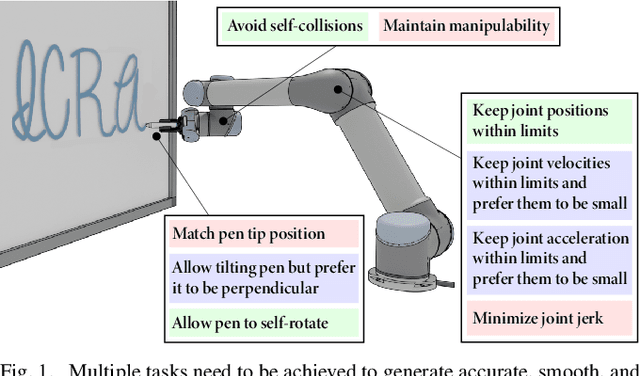
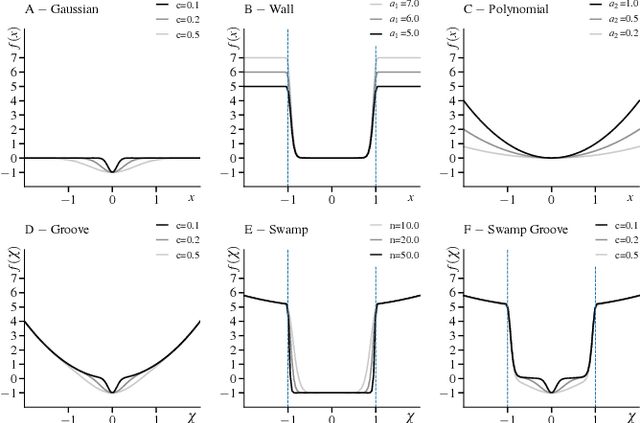
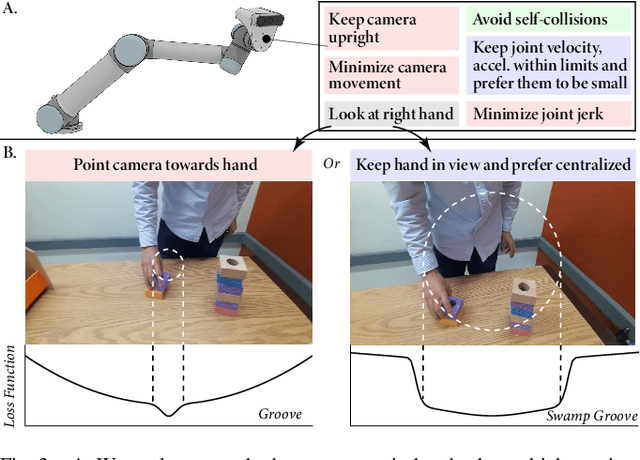
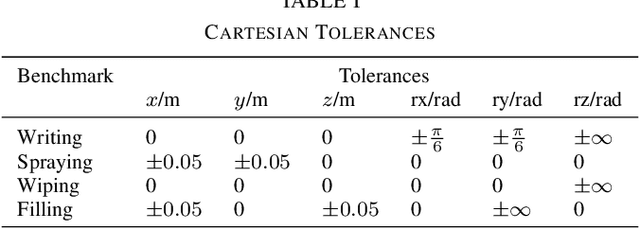
Abstract:Generating feasible robot motions in real-time requires achieving multiple tasks (i.e., kinematic requirements) simultaneously. These tasks can have a specific goal, a range of equally valid goals, or a range of acceptable goals with a preference toward a specific goal. To satisfy multiple and potentially competing tasks simultaneously, it is important to exploit the flexibility afforded by tasks with a range of goals. In this paper, we propose a real-time motion generation method that accommodates all three categories of tasks within a single, unified framework and leverages the flexibility of tasks with a range of goals to accommodate other tasks. Our method incorporates tasks in a weighted-sum multiple-objective optimization structure and uses barrier methods with novel loss functions to encode the valid range of a task. We demonstrate the effectiveness of our method through a simulation experiment that compares it to state-of-the-art alternative approaches, and by demonstrating it on a physical camera-in-hand robot that shows that our method enables the robot to achieve smooth and feasible camera motions.
MotionBenchMaker: A Tool to Generate and Benchmark Motion Planning Datasets
Dec 13, 2021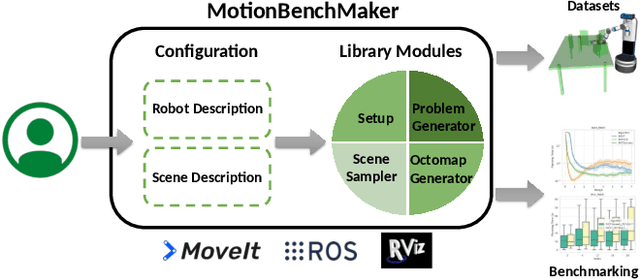
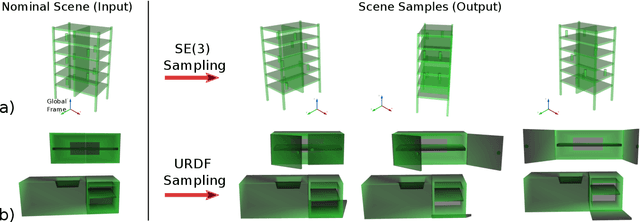

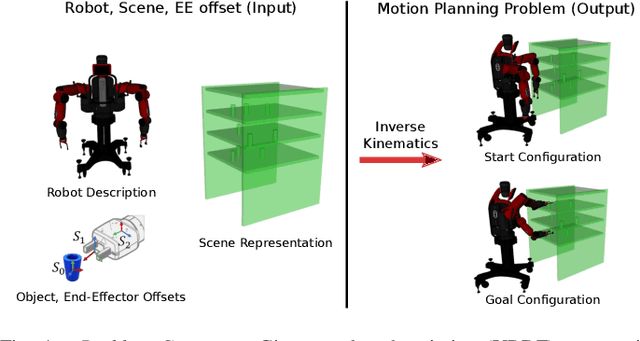
Abstract:Recently, there has been a wealth of development in motion planning for robotic manipulation new motion planners are continuously proposed, each with their own unique strengths and weaknesses. However, evaluating new planners is challenging and researchers often create their own ad-hoc problems for benchmarking, which is time-consuming, prone to bias, and does not directly compare against other state-of-the-art planners. We present MotionBenchMaker, an open-source tool to generate benchmarking datasets for realistic robot manipulation problems. MotionBenchMaker is designed to be an extensible, easy-to-use tool that allows users to both generate datasets and benchmark them by comparing motion planning algorithms. Empirically, we show the benefit of using MotionBenchMaker as a tool to procedurally generate datasets which helps in the fair evaluation of planners. We also present a suite of 40 prefabricated datasets, with 5 different commonly used robots in 8 environments, to serve as a common ground to accelerate motion planning research.
Strobe: An Acceleration Meta-algorithm for Optimizing Robot Paths using Concurrent Interleaved Sub-Epoch Pods
Jun 01, 2021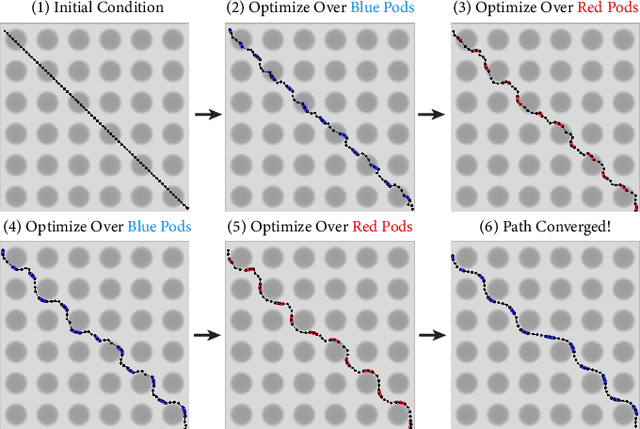
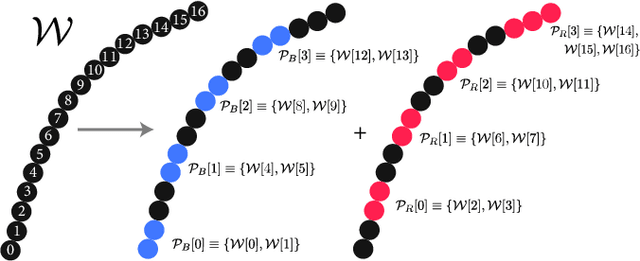


Abstract:In this paper, we present a meta-algorithm intended to accelerate many existing path optimization algorithms. The central idea of our work is to strategically break up a waypoint path into consecutive groupings called "pods," then optimize over various pods concurrently using parallel processing. Each pod is assigned a color, either blue or red, and the path is divided in such a way that adjacent pods of the same color have an appropriate buffer of the opposite color between them, reducing the risk of interference between concurrent computations. We present a path splitting algorithm to create blue and red pod groupings and detail steps for a meta-algorithm that optimizes over these pods in parallel. We assessed how our method works on a testbed of simulated path optimization scenarios using various optimization tasks and characterize how it scales with additional threads. We also compared our meta-algorithm on these tasks to other parallelization schemes. Our results show that our method more effectively utilizes concurrency compared to the alternatives, both in terms of speed and optimization quality.
Single-query Path Planning Using Sample-efficient Probability Informed Trees
May 31, 2021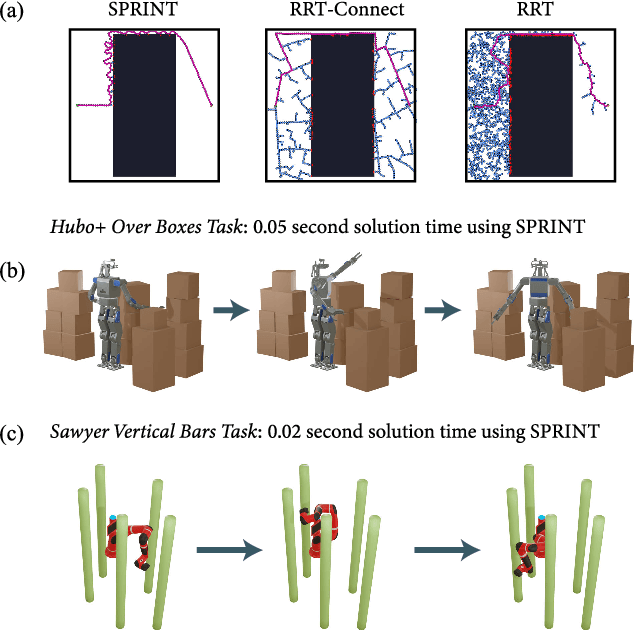
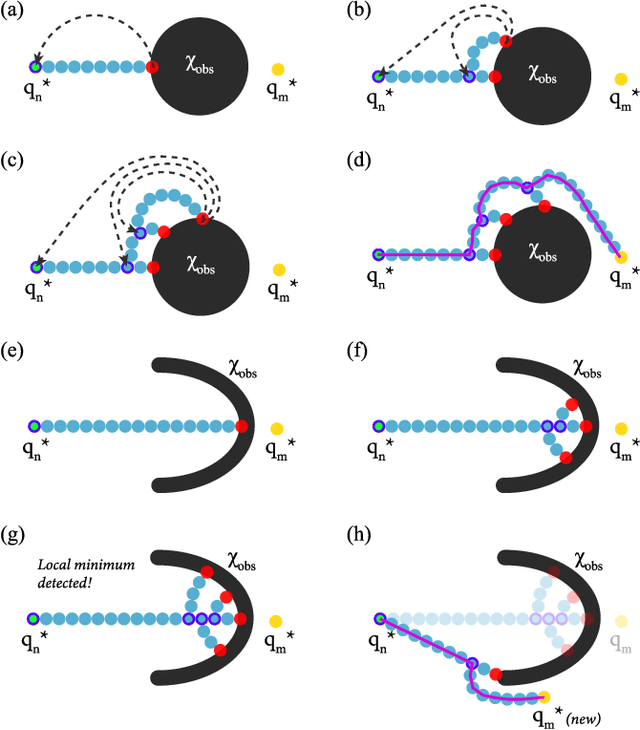
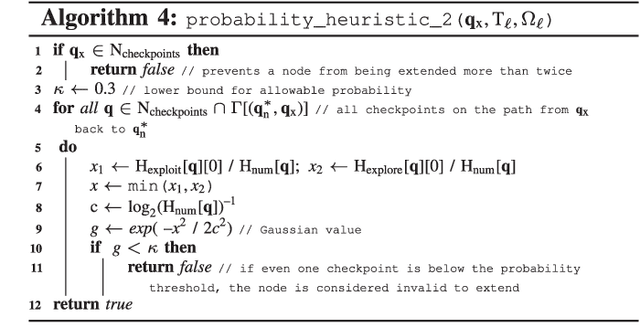
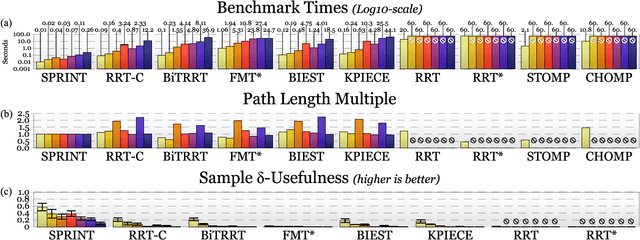
Abstract:In this work, we present a novel sampling-based path planning method, called SPRINT. The method finds solutions for high dimensional path planning problems quickly and robustly. Its efficiency comes from minimizing the number of collision check samples. This reduction in sampling relies on heuristics that predict the likelihood that samples will be useful in the search process. Specifically, heuristics (1) prioritize more promising search regions; (2) cull samples from local minima regions; and (3) steer the search away from previously observed collision states. Empirical evaluations show that our method finds shorter or comparable-length solution paths in significantly less time than commonly used methods. We demonstrate that these performance gains can be largely attributed to our approach to achieve sample efficiency.
 Add to Chrome
Add to Chrome Add to Firefox
Add to Firefox Add to Edge
Add to Edge